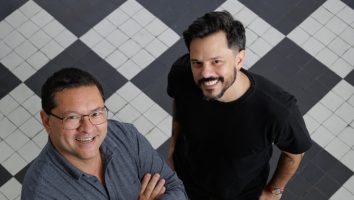The fruits of Nickelodeon’s efforts to scan the planet and unearth fresh animation talent were picked over recently, when Nick’s four-year-old Worldwide Development Group (WDG) and a panel of six judges (selected for their animation acumen) chose six winners of the Global Animation Storyboard Competition. In addition to the rush of being given the nod of discovery as ‘innovative talent’ by a panel of top animation execs from around the world, the winners are given the opportunity to develop their kid properties for broadcast on Nick stations globally.
Hey Arnold! creator and executive producer Craig Bartlett, one of this year’s judges, would like to see The Nickelodeon Global Animation Storyboard Competition become an annual event and a regular part of international animation festivals. ‘Students’ work can reflect a mentality of `anything goes’ and is one of the last chances that you have to be truly independent and uninfluenced.’
Explaining the thought processes behind the adjudication, Bartlett explains: ‘We were looking for properties that were kid-friendly and looked at the world from a kid’s point of view, but because they were international, they had to work without language, to communicate with and be understood by kids anywhere.’
Each two- to three-minute entry could be rendered in any form of animation. The competition was open to both seasoned creators and to students, resulting in winners that were alternately slick and raw. The winning storyboards are…
The Hackers, an example of a more polished entry from Denmark’s Craig Frank, had very strong character design. The toon tells the story of two friends, Snagger and Noodles, and where their computer-hacking exploits lead them. In this cyberadventure, the duo deals with aliens, ends up in a lot of hot water, and experiences a fair share of digital mayhem.
U.S.-made Who’s Babysitting Who?, by Shaun Reimers, is every babysitter’s nightmare and every kid’s fantasy, revolving around outsmarting the babysitter and staying up as late as possible. ‘This one is hilarious,’ says Bartlett. ‘Right off you say, now there’s a TV series created by someone who obviously knows how to tell a story.’ The 2-D animated project follows its main character Bobby, who has lizard-like capabilities such as blending into his environment, shedding his skin and the ability to grow back lost limbs.
The Big Traffiction, an example of a less mainstream storyboard, was a Hungarian team effort by Zoltan Lehotay and Agnes Hoos. The 2-D animated offering follows nine-year-old Ernie and his dog Trafalger as they get trapped on an island in the street when the light turns red while they’re crossing. Ernie’s vivid imagination soon takes over, turning the passing cars into a procession of monsters. According to Bartlett, The Big Traffiction’s appeal lies in its use of improvisation: ‘You just don’t know what is going to happen next.’
Of Argentina’s 2-D offering Brainboy and Burt, Bartlett recalls that ‘you could look at it and practically hear it.’ Created by Javier Fernando Rodriguez, Brainboy, as his name would indicate, has a very large noodle-complete with limitless telekinetic and telepathic powers. Conversely, Burt, Brainboy’s brother, is completely lacking in the gray matter department. Trouble ensues when Brainboy transfers his powers to Burt so that his little brother may do all the housework. Bartlett further likened this winner’s style to that of Ren and Stimpy.
Music Monster is the U.K.’s computer-animated delivery by Tia Perkins. Music Monster is an enthusiastic and good-natured character, except when confronted by ugly sounds and a break in the rhythm that dictates his life. He’s a maestro whose every action composes a personal soundtrack in the narrative that follows the events of his day. ‘Wildly creative, looser and exuberant’ are words Bartlett uses to describe this piece of work. ‘It is similar to the style of the NFB-animated stuff-lots of wiggly lines.’ Music Monster is representative of the more unreserved student work entered into the competition.
The only cel-animated winner, Mum’s Birthday, was created in Spain by Carolina Lopez Caballero. Conveying a very Spanish style, the short worked well with the international sensibility that Nickelodeon was trying to achieve with this competition. ‘The humor was more outrageous and off-the-wall,’ explains Bartlett. Amidst looser, individual and inventive art styles, the story of three sisters in search of a birthday gift for their mother plays out. Collecting their savings, they go shopping and take some very bad advice from a less than helpful shop assistant, leading to some unexpected results.
In spring 2000, the winners from this competition will be aired on Toons From Planet Orange II, a half-hour animation special featuring the shorts. Following that, Nickelodeon will consider commissioning new series based on the winners. The WDG is a team comprised of Nickelodeon creative and development execs representing Nick channels throughout the world.
Rounding out the group of judges were: Magnus Carlsson (Sweden), creator and director of the animated series Robin and The Three Friends and Jerry; Luis Cook (U.K.), creative director at Aardman Animations; Mauricio de Sousa (Brazil), president and CEO of Mauricio de Sousa Productions and creator of the cartoon Monica; Noboru Ishiguro (Japan), an animation director and president of Artland; and Deanne Taylor (Australia), winner of the ASIFA Annie Award for Outstanding Individual Achievement for Artistic Excellence in the field of Animation.





















